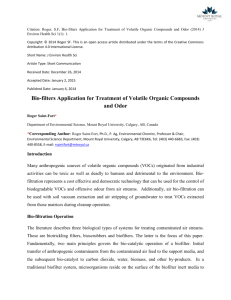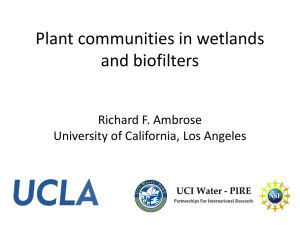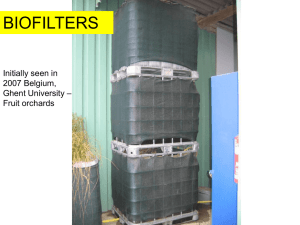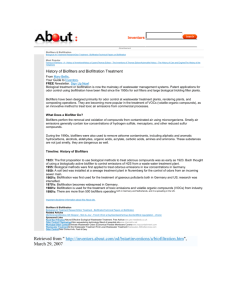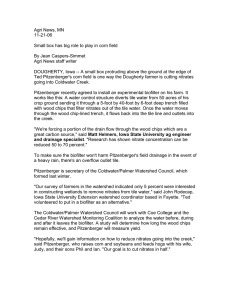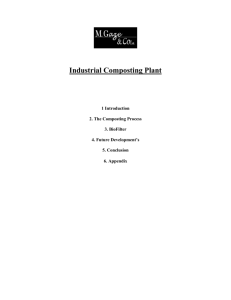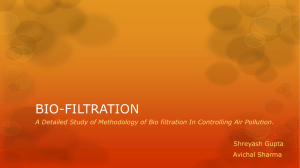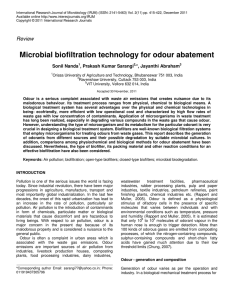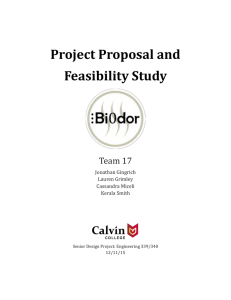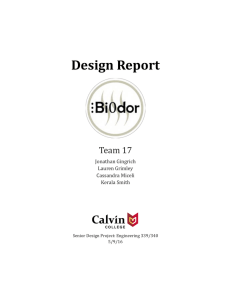Biofiltration and its application in treatment of
advertisement
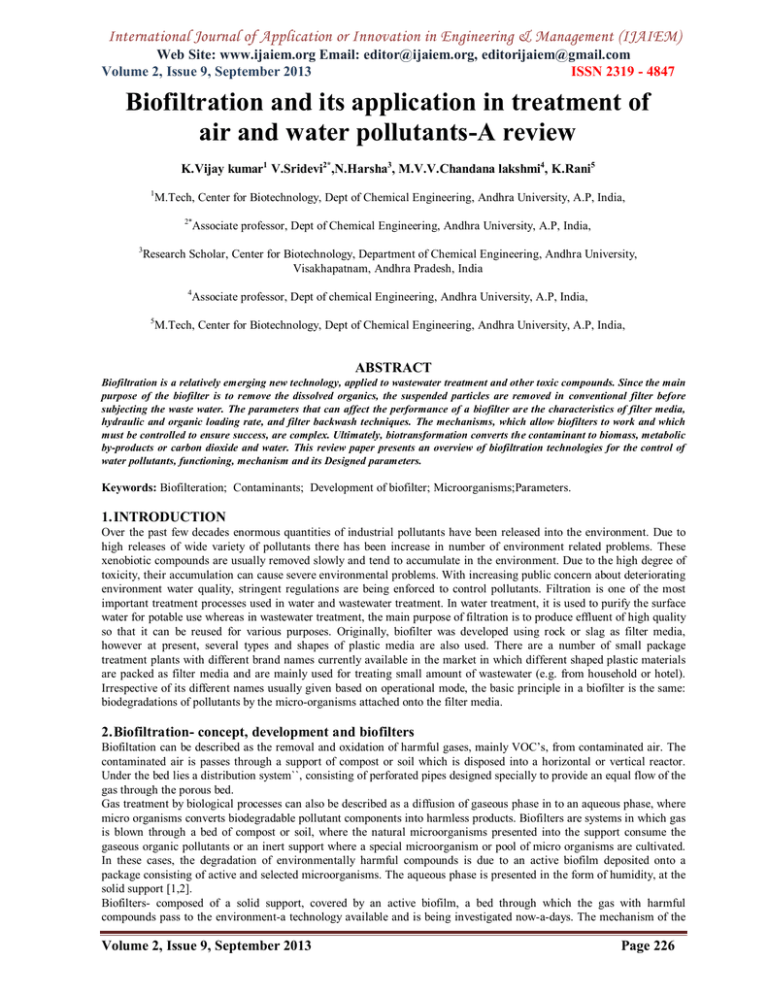
International Journal of Application or Innovation in Engineering & Management (IJAIEM) Web Site: www.ijaiem.org Email: editor@ijaiem.org, editorijaiem@gmail.com Volume 2, Issue 9, September 2013 ISSN 2319 - 4847 Biofiltration and its application in treatment of air and water pollutants-A review K.Vijay kumar1 V.Sridevi2*,N.Harsha3, M.V.V.Chandana lakshmi4, K.Rani5 1 M.Tech, Center for Biotechnology, Dept of Chemical Engineering, Andhra University, A.P, India, 2* Associate professor, Dept of Chemical Engineering, Andhra University, A.P, India, 3 Research Scholar, Center for Biotechnology, Department of Chemical Engineering, Andhra University, Visakhapatnam, Andhra Pradesh, India 4 5 Associate professor, Dept of chemical Engineering, Andhra University, A.P, India, M.Tech, Center for Biotechnology, Dept of Chemical Engineering, Andhra University, A.P, India, ABSTRACT Biofiltration is a relatively emerging new technology, applied to wastewater treatment and other toxic compounds. Since the main purpose of the biofilter is to remove the dissolved organics, the suspended particles are removed in conventional filter before subjecting the waste water. The parameters that can affect the performance of a biofilter are the characteristics of filter media, hydraulic and organic loading rate, and filter backwash techniques. The mechanisms, which allow biofilters to work and which must be controlled to ensure success, are complex. Ultimately, biotransformation converts the contaminant to biomass, metabolic by-products or carbon dioxide and water. This review paper presents an overview of biofiltration technologies for the control of water pollutants, functioning, mechanism and its Designed parameters. Keywords: Biofilteration; Contaminants; Development of biofilter; Microorganisms;Parameters. 1. INTRODUCTION Over the past few decades enormous quantities of industrial pollutants have been released into the environment. Due to high releases of wide variety of pollutants there has been increase in number of environment related problems. These xenobiotic compounds are usually removed slowly and tend to accumulate in the environment. Due to the high degree of toxicity, their accumulation can cause severe environmental problems. With increasing public concern about deteriorating environment water quality, stringent regulations are being enforced to control pollutants. Filtration is one of the most important treatment processes used in water and wastewater treatment. In water treatment, it is used to purify the surface water for potable use whereas in wastewater treatment, the main purpose of filtration is to produce effluent of high quality so that it can be reused for various purposes. Originally, biofilter was developed using rock or slag as filter media, however at present, several types and shapes of plastic media are also used. There are a number of small package treatment plants with different brand names currently available in the market in which different shaped plastic materials are packed as filter media and are mainly used for treating small amount of wastewater (e.g. from household or hotel). Irrespective of its different names usually given based on operational mode, the basic principle in a biofilter is the same: biodegradations of pollutants by the micro-organisms attached onto the filter media. 2. Biofiltration- concept, development and biofilters Biofiltation can be described as the removal and oxidation of harmful gases, mainly VOC’s, from contaminated air. The contaminated air is passes through a support of compost or soil which is disposed into a horizontal or vertical reactor. Under the bed lies a distribution system``, consisting of perforated pipes designed specially to provide an equal flow of the gas through the porous bed. Gas treatment by biological processes can also be described as a diffusion of gaseous phase in to an aqueous phase, where micro organisms converts biodegradable pollutant components into harmless products. Biofilters are systems in which gas is blown through a bed of compost or soil, where the natural microorganisms presented into the support consume the gaseous organic pollutants or an inert support where a special microorganism or pool of micro organisms are cultivated. In these cases, the degradation of environmentally harmful compounds is due to an active biofilm deposited onto a package consisting of active and selected microorganisms. The aqueous phase is presented in the form of humidity, at the solid support [1,2]. Biofilters- composed of a solid support, covered by an active biofilm, a bed through which the gas with harmful compounds pass to the environment-a technology available and is being investigated now-a-days. The mechanism of the Volume 2, Issue 9, September 2013 Page 226 International Journal of Application or Innovation in Engineering & Management (IJAIEM) Web Site: www.ijaiem.org Email: editor@ijaiem.org, editorijaiem@gmail.com Volume 2, Issue 9, September 2013 ISSN 2319 - 4847 process consists of removing the unwanted odorous organic compound from the gaseous phase, concurring its absorption or adsorption onto the porous solid phase of the biofilter or dissolution into the liquid phase, and then oxidation of this compounds by microorganisms [3,4]. A range of technologies is available to treat odorous air from wastewater treatment plants, sulphur effluents, industrial processes and industrial waste water such as organic compounds. Many kinds of apparatus can be designs and many kinds of media are available for this purpose. Biofiltration is advantageous because it does not require large amounts of energy during operation and besides produces a relatively low toxicity waste steam [4,3]. 3. Characteristics , advantages and disadvantages of biofiltration Immobilized biomass Immobilized water phase Single reactor and the advantages and disadvantages are shown in the below table-1. Table:1- Advantages and disadvantages of biofiltration: Advantages Disadvantages Lower capital cost Lower operation costs Lower chemical usage No combustion source Biofiltration units can be designed to fit in space and size to the industrial unit setting, operation spaces. System versatile to treat odors, toxic compounds and voc’s. Efficiency > 90% for the low contaminant cocc. (<1000ppm) Possibility of different media, microorganisms, and operational conditions, for many emission points. System is not fitted for compounds, which have low adsorption and degradation rates, mainly chlorinated voc’s. Large biofilters units or large areas are required to treat contaminated sources with high chemical emissions. Source of emission that vary severely or produces spikes, can be detrimental to the biofilter performance and to the microbial population. Biofilters require long period of acclimation for microbial population, weeks or even months, mainly for voc treatment. Because of its wide range of application, many studies have been done on biofiltration system in last few decades. However, theoretically it is still difficult to explain the behavior of a biofilter. The growth of different types of microorganisms in different working conditions makes it impossible to generalize the microbial activities in a biofilter. The biofilters operated at different filtration rates and influent characteristics can have diverse efficiency for different target pollutants. Besides, due to some of the operational drawbacks of the biofilter such as performance fluctuation, maintenance of biomass, and disinfection adequacy of the biofilter effluent, research on biofiltration process has become imperative. This paper mainly focuses on the theoretical and modeling aspects, and the performance of the biofilter in removing organics, nutrients, and some specific pollutants from water and wastewater. Biofiltration is as an economically viable treatment process, used capture pollutants from air & water. The contaminated air is passed through soil, peat, or compost, the naturally present microorganisms also begin to biodegrade the air contaminants, which led to the development of soil biofilters, in which soil with low clay and high organic carbon content was packed in a bed and contaminated air was passed through the soil bed to biodegrade the air contaminants. However, as more research was conducted on this simple process, it became clear that the biodegradation rates were low and hence the size of the biofilter bed required to achieve high destruction efficiencies was very large. Since, compost had a higher concentration of micro organisms, compost became the media of choice for biofilters. Major problems encountered were settling of the compost, resulting in increased gas-phase pressure drop, availability of nutrients, such as nitrogen and phosphorus, pH maintenance, and drying of the compost material due to moisture transferring to the flowing gas phase. These problems were countered to some extent by adding wood chips, which provided mechanical support to minimize settling, humidifying the inlet air to maintain proper water content in the compost material, adding lime pellets for pH control, and fortifying the compost with fertilizers containing nitrogen and phosphorus compounds. Further, in compost beds, it was necessary to have shallow beds (height < 1.5 m or 4.5 feet), to prevent compaction of the material and drying of the bed from the top surface. Currently, there are several companies that offer compost biofilters for treatment of odorous and volatile chemicals. Volume 2, Issue 9, September 2013 Page 227 International Journal of Application or Innovation in Engineering & Management (IJAIEM) Web Site: www.ijaiem.org Email: editor@ijaiem.org, editorijaiem@gmail.com Volume 2, Issue 9, September 2013 ISSN 2319 - 4847 Figure.1-Schematics of Biofiltration system for advanced waste water treatment In advanced wastewater treatment, biofilter can be used along with conventional physico-chemical processes such as coagulation, flocculation, filtration and sedimentation (Fig. 1). The conventional filter and the biofilter units can be combined together depending on the suspended solid concentration. Since the main purpose of the biofilter is to remove the dissolved organics, the suspended particles are removed in conventional filter before subjecting the waste water to the biofiltration system. 4. How Bio filtration occurs? Figure.2-- Process of Biofiltration Microorganisms fixed to a porous medium are used in the bio-filtration process to break down pollutants present in the wastewater stream. The microorganisms growing a bio-film on the surface of the medium or are suspended in the water phase surrounding the medium particles. The filter bed medium consists of relatively inert substances which ensure large surface attachment areas and additional nutrient supply. The overall effectiveness of a biofilter is largely governed by the properties and characteristics of the support medium, which include porosity, degree of compaction, water retention capabilities and the ability to host microbial populations. Critical biofilter operational and performance parameters include the microbial inoculation, medium pH, temperature, the medium moisture, and nutrient content. The progress of filtration process, microorganisms (aerobic, anaerobic, facultative, bacteria, fungi, algae, and protozoa) are gradually developed on the surface of the filter media and form a biological film or slim layer known as biofilm. The crucial point for the successful operation of biofilter is to control and maintain a healthy biomass on the surface of the filter (Fig.2). 5. Mechanism of biofiltration: The mechanisms by which microorganisms can attach and colonize on the surface of the filter media of a biofilter are transportation of microorganisms, initial adhesion, firm attachment and colonization. The transportation of microorganisms to the surface of the filter media is further controlled by four main processes: •Diffusion (Brownian motion), convection, sedimentation due to gravity, and active mobility of the microorganisms. The following parameters are taken into consideration to estimate the attachment of microorganisms on the surface of the filter media: • The steric effect, hydrophobicity of the microorganisms, contact angle, and electrophoretic mobility values. 6. Role of microorganisms in biofiltration techniques Regarding the microbiological potential of biofilters, different aspects have been recently studied: isolation and characterization [5-11], the use of pure cultures of bacteria [12-14], fungi[15,16]; mixed microbial populations [17]; Microorganisms presented in biofiltration systems are predominantly aerobic. Oxygen supply is abundant in the incoming air but it has to be dissolved into the water phase to be available to the micro flora in the biofilm. Depending on the Volume 2, Issue 9, September 2013 Page 228 International Journal of Application or Innovation in Engineering & Management (IJAIEM) Web Site: www.ijaiem.org Email: editor@ijaiem.org, editorijaiem@gmail.com Volume 2, Issue 9, September 2013 ISSN 2319 - 4847 composition of the off gas and physic-chemical conditions in the filter, different mixed populations may develop, but most of the microorganisms found in biofilters are bacteria [18], van groenestijin & hesselink, 1993 [19] found that most of the bacteria are coryneforms and endospore formers and only occasionally pseudomonads. Actinomycetes are mainly represented by streptomyces spp. Yeast and fungi are less abundant in filters. Most of the filamentous fungi belong to the Mucorales (mortierella, rhizopus) and deuteromycetes (Penicillium, Aspergillus, Cladosporium, Fusarium, trichoderma, Alternaria and botrytis ) [18]. 7. Design Considerations The parameters that can affect the performance of a biofilter are the characteristics of filter media, hydraulic and organic loading rate, and filter backwash techniques. Other factors that can influence the performance of a biofilter are the temperature and the presence of oxidants, i.e. O3, H2O2, Cl2, and NH4Cl etc. in the influent[20,21]. These factors should be carefully studied before designing a biofiltration system. 7.1. Filter Media The economical and efficient operation of a biofilter highly depends on the characteristics of its filter media. While selecting the filter media, one should also consider the source and concentration of targeted pollutants. For the treatment of primary wastewater, the right choice of the filter media can be the blast furnace slag or granite or synthetic media depending upon the volume of wastewater, whereas for the treatment of tertiary wastewater, air stream containing the biofilter media should provide: (i) a suitable surface for quick biomass growth, (ii) larger surface area for biomass growth, and (iii) good surface texture to hold biomass against shear and sloughing. The effect of types of media on the performance of the biofilter is seen in (Fig.3). Figure.3--Effect of types of filter media on the performance of biofilter . 7.2. Empty Bed Contact Time (EBCT) The contact time, usually expressed as empty bed contact time (EBCT), is a key design and operating parameter of a biofilter. Zhang and Huck [1996b][22] have introduced the concept of dimensionless contact time incorporating EBCT, specific surface area of the medium, substrate diffusivity and rate of biodegradation. Usually the percentage removal of organic substances increases with increase in contact time up to an optimum value. Both the filter depth and hydraulic loading can be changed to increase the EBCT. The effect of EBCT on the performance of biofitler is seen in (Fig.4). Figure.4-- Effect of EBCT on the performance of biofilter (Chabrol model) Volume 2, Issue 9, September 2013 Page 229 International Journal of Application or Innovation in Engineering & Management (IJAIEM) Web Site: www.ijaiem.org Email: editor@ijaiem.org, editorijaiem@gmail.com Volume 2, Issue 9, September 2013 ISSN 2319 - 4847 7.3. Filter Backwash It is important to select an appropriate filter backwashing technique for successful operation of a biofilter. The biomass attached to the filter media has to be carefully maintained during backwashing[23-27]. Previous researches have shown no major loss of biomass during backwash of the biofilter[23,28]. Servais et al. [1991] [29] backwashed the GAC biofilter with air scour and water routinely every 50-100 hours of continuous run, but no significant difference in vertical biomass profiles before and after backwash was observed. 7.4. Temperature The effect of temperature on the bacterial activity on the biofilter and hence the performance of the biofilter can be seen in (Fig.5). The activities of bacterial community adapted at 10 oC and 20oC were found to increase with increase in temperature in range of 10-30oC Figure.5--Percentage of bacterial activity with respect to maximal activity with respect to temperature. 8. CONCLUSION From the above discussion it can be concluded that there is a high possibility for effective application of biofilters for removal of toxic heavy metals from contaminated water in large scale. In short, the biofilters are having emerging applications for the treatment of heavy metals contaminated wastewater. It is very important to note that a good system to biofiltration provides the best condition for the microorganisms and, consequently, will achieve a high efficiency. Biofilter can effectively be used in an economical manner to produce high quality of effluent due to its consistent TOC removal efficiency, long operational life and simplicity in operation. REFERENCES [1] D. L. Soto, “Eliminacion de toluene por medio de filtros.Evaluacion del espesor active”, Adv. ingenieria .Quim, (5),pp. 756-765, 1995. [2] M. W. Reij, “Membrane bioreactors for waste gas treatment”, J. Biotechnol, (1), pp.65-74, 1998. [3] S. F. Adler, “Biofiltration-a primer, Chem. Eng. Prog, 97(4), pp.33-41, 2001. [4] J. E. Burgess, “Developments in odour control and waste gas treatment”, biotechnology, 2001. [5] B. Bendinger, “Studies on the microbiology and the degradation capacities of a biofilter”, In Dechema Biotechnology Conf, 4. VCH Verlagsgesellschaft, Frankfrut, pp. 529-533, 1990. [6] K. S. Cho, “Removal characteristics of hydrogen sulphide and methanethiol by Thiobacillus sp. Isolated from peat in biological deodorization,” J. Ferment. Bioeng, (71), pp. 44-49, 1991. [7] Z. Shareefdeen, “Biofiltration of methanol vapours”, Biotechnol. Bioeng, (41), pp. 512-524, 1993. [8] A. Mallakin and O .P. Ward, “Degradation of BTEX compounds in liquid media and in peat biofilters”, J. Ind. Microbiol, (16), pp. 309- 318, 1996. [9] V. Andreoni, “Characterization of a biofilter treating toluene contaminated air”, Biodegradation,(7), pp. 397-404, 1997. [10] A. Lipski, “Detection of styrene-degrading microorganisms from biofilters”, In Proc Int Symp. Biological Gas Cleaning, edited by W L.Prins. J Van Ham, VDI Verlag, Maastrich, Dusseldorf, pp.265-268, 1997. [11] K. Reichert, “Degradation of dimethyl disulpide and dimethyl sulphide by Pseudonocardia Strains”, In Proc Int Symp Biological Gas Cleanng, Maastrich 1997, edited by W L.Prins, VDI Verlag, Dusseldorf, pp.269-272, 1997. [12] R. M. M. Diks, “The influence of NaCl on the degradation rate of dichloromethane oby Hypho microbium sp”., Biodegradation, (5), pp.129-141, 1994. [13] M. Megharaj , “Recalcitrance of 1,1-dichloro-2,2 bis (p-chlorophenyl) ethylene to degradation by pure cultures of 1,1 diphenylethylene-degradation aerobic bacteria”, Appl. Microbiol. Biotechnol, (49), pp. 337-342, 1998. Volume 2, Issue 9, September 2013 Page 230 International Journal of Application or Innovation in Engineering & Management (IJAIEM) Web Site: www.ijaiem.org Email: editor@ijaiem.org, editorijaiem@gmail.com Volume 2, Issue 9, September 2013 ISSN 2319 - 4847 [14] M. Krishna, “Performance evolution of a Thiobacillus denitrifiants immobolized biofilter for a removal of oxides of nitrogen”, Proc USC-TRG Conf biofiltration, eited by F E Reynolds Jr. The Reynolds Group Publ, Tustin, CA, pp.191- 200, 2000. [15] H. H. J. Cox, “Performance of a styrene degradation biofilter containing the yeast, Exopholiala jeanselmei”, Biotechnol. Bioeng, (53), pp. 259-266, 1997. [16] J.R. Woertz and K.A. kinney, “Use of the fungus Exophilia lecanii-corni to degarde a mixture of VOC’s”., Proc USC-TRG Conf Biofiltration. Las Angeles. 2000, edited by F E Reynolds Jr. The Reynolds Group Publ. Tustin, CA, pp.151- 158, 2000. [17] H. H. J. Cox and M. A. Deshusses, “Chemical removal of biomass from waste air biotrickling filters: Screening of chemicals of potential interest”, Water. Res, (33), pp. 2383-2391, 1999. [18] J .W. Van groenestijin and P. G.M. Hesselink, “Biotechniques for air pollution control”, Biodegradation, (4), pp.283-301, 1993. [19] M.G. Rieneck, “Mikrobiologisch Methoden zur Charakterisierung von Biofiltermaterialien”, In Biotechniques for Ai Pollution Abatement and Odour control policies, Proc Int Symp Maastricht. 27-29 October 1991, edited by Dragt A J & Ham J van, Elsevier, Amsterdam, pp.85-95, 1992. [20] D. Urfer, P. M. Huck, S. D. J. Booth and B.M. Coffey, “Biological Filtration for BOM and Particle Removal: A Critical Review”, J. AWWA, 89(12), pp.83, 1997. [21] S. Goel, R. M. Hozalski and E. J. Bouwer, “Biodegradation of NOM: Effect of NOM Source and Ozone Dose”, J. AWWA, 87(1), pp.90, 1995. [22] S. Zhang and P.M. “Huck Parameter Estimation for Biofilm Processes in Biological Water Treatment”, Water Res, 30(2), pp. 456, 1996b. [23] R. Ahmad and A. Amirtharajah, “Detachment of Particles during Biofilter Backwashing”, J. AWWA, 90(12), pp.74, 1998. [24] E. J. Bouwer and P. B. Crowe, “Biological Processes in Drinking Water Treatment”, J. AWWA, 80(9), pp.82 1988. [25] G. P. Bablon, C. Ventresque and R. Ben Aim, “Developing a Sand- GAC Filter to Achieve High Rate Biological Filtration”, J. AWWA, 80(12), pp. 47, 1988. [26] S. L. Graese, V. L. Snoeyink and R.G. Lee, “Granular Activated Carbon Filter-Adsorber Systems”, J. AWWA, 79(12), pp. 64, 1987. [27] R. J. Miltner, R. S. Summers and J. Z. Wang, “Biofiltration Performance: Part 2, Effect of Backwashing”, J. AWWA, 87(12), pp. 64, 1995. [28] P. Lu and P. M. Huck, “Evaluation of the Methods for Measuring Biomass and Biofilm Thickness in Biological Drinking Water Treatment”, Proceedings AWWA WQTC, Miami, 1993. [29] P. Servais, G. Billen, C. Ventresque and G. P. Bablon, “Microbial Activity in GAC Filters at the Choisy-le-Roi Treatment Plant”, J. AWWA, 83(2), pp. 62, 1991. Volume 2, Issue 9, September 2013 Page 231
